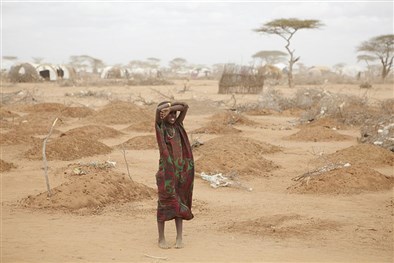source: www.bbc.co.uk
Every 15 seconds a child dies of hunger, says a campaign by charities urging G8 leaders to pledge more aid for the world's poorest families - or every 10 seconds, according to the latest version of the slogan. But does this paint an accurate picture?
There is enough food for everyone, but not everyone has enough food, says the Enough Food for Everyone If campaign.
"In every minute of every day, four children die of hunger," intones the comedian Eddie Izzard in one of its promotional videos, before the 15-second figure was updated to 10 seconds on 6 June.
The stat is a variation on another, used seven years ago in the Make Poverty History campaign - when a host of celebrities from the world of music, cinema and fashion appeared on a video clicking their fingers at regular intervals. Then the message was that a child dies unnecessarily as a result of extreme poverty every three seconds.
Stats about deaths occurring every few seconds have been around for years.
This latest, the 10-second one, is based on a figure from a very reputable source - The Lancet, an internationally renowned journal which recently published a paper saying that more than three million children died of undernutrition in 2011.
To get their attention-grabbing statistic, the If campaign managers have divided the number of seconds in a year by that number - three million.
It resonates with people more than the three million figure itself, according to If spokesman Jack Lundie.
"Large figures are notoriously difficult to visualise and imagine, especially when you get into millions," he says.
"Also we want to focus on the individual, and these expressions help to humanise a problem. So we need a short, accessible phrase that in a short period of time will convey both the emotional impact of the problem that we're addressing, but also give that sense of scale and urgency that will precipitate some kind of action."
But another major group that tackles food problems around the world, the United Nations World Food Programme (WFP), now disapproves of this tactic.
"There's a real temptation to use those kinds of statistics because they really do grab the headlines - you can't ignore that because it's such a horrifying image," says Jane Howard, from the WFP.
But, she says, it is "a bit misleading".
The WFP itself once used to claim that a child died of hunger every six seconds, but stopped using this slogan around 2008.
The numbers can change from year to year, Howard points out, depending on the latest research, "and it gets very confusing because the old figures end up lying around on the internet".
And more importantly, she argues, "the science is actually saying something quite different".
So what is the science saying? Well, if, to you, the claim that one child is dying every 10 seconds because of hunger conjures up images of starving children, you might be surprised.
In most cases, that's not what's happening.
"There are certainly extreme circumstances where children starve to death - and I'm thinking of the recent famine in parts of Somalia," Howard says.
"But the truth is that the vast majority of those numbers that we're talking about, are children who, because they haven't had the right nutrition in the very earliest parts of their lives, are really very susceptible to infectious diseases, like measles.
"A child that's had good nutrition would just shrug it off, but for a child that's really fragile and has a compromised immune system it becomes really life threatening."
The If campaign highlights an important issue, but is it wrong to use the word "hunger" if it might inaccurately suggest children are starving to death?
"I could understand if members of the public made that inference, and that would be mistaken," Lundie says. "We're not saying that children in this particular instance are starving to death, and we explain exactly how it works. But I think the term 'hunger' is something that people relate to."
The fact that poor nutrition is identified as an underlying cause of death means that there's also some double counting going on. When you hear that one child dies every few seconds from water-related diseases, for example- or from poverty - some of these children will be the same ones that are said to be dying every few seconds from hunger.
Another surprise is to discover who these children are and that they are often not even, as the adverts sometimes put it, "going to bed hungry".
Most of the nutrition-related deaths are in countries that are not suffering from famine or conflict, according to Professor Robert Black of the Johns Hopkins Bloomberg School of Public Health in the United States, who calculated the three million figure that the 10-seconds statistic is based on.
"These are not the poorest countries in the world. They are countries such as India or Nigeria or many other countries in Asia or Africa that really could do better - that have the resources to feed children within the country.
"Certainly the poorest have the greatest problems with undernutrition, but even then there might be sufficient food to feed children. The difficulty is achieving a high enough quality diet - a diet that is dominated by cereals or starches would not be a high enough quality diet to achieve the nutrition that's needed in the first two years of life."
most cases, the problem could be resolved through nutrition education, Black says.
In some cultures, women don't get to eat the best food in the household, which can mean children are born underweight. Milk and meat may also be avoided for cultural reasons, as they are in parts of India for example. And sometimes it's just not fully appreciated how important fruit and vegetables are.
A quarter of the deaths can be attributed to inadequate breast-feeding, Professor Black estimates, -with many families not realising that, up to six months of age, babies need to be exclusively fed on breast milk for the nutrients it provides, but also because it protects them from exposure to contaminated food.
So there's a much more complicated picture than the headline statistic - that one child dies every 10 seconds because of hunger - suggests.
But you have to simplify a message if you are to get people's attention, according to Jack Lundie.
"Yes, it may be that in what we would call our top-line messaging you don't get all the information about the entire problem, but I don't think it would be realistic to expect that to happen from a very short piece of communication.
"In terms of creating a conversation in which people can be informed, you first have to get their attention - their emotional attention. People are very busy so you need an instantly accessible understanding to open a conversation."
Poor nutrition is a serious problem - the three million children who are thought to have died because of it in 2011 represent almost half of all infant deaths. But there are signs of progress.
"There's been a decrease in the number of excess deaths - not a very large decrease - but still some improvement since we last studied this [in 2008], and the attention given to these issues of nutrition in low- and middle-income countries has really increased remarkably in the last five years," says Prof Black.
"I'm very optimistic that the world is now paying attention to the problems and will find the solutions."














